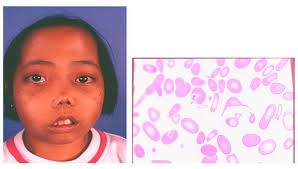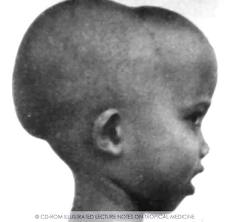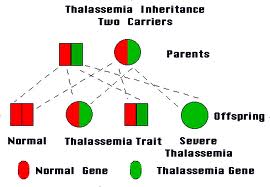Thalassemia is a group of genetic disorders characterized by production of abnormal hemoglobin in red blood cells.
It is sometimes called Mediterranean anemia, von Jaksch anemia or Cooley’s anemia, named after the physicians who first diagnosed it. Thalassemia affects all races. People of Mediterranean descent, such as Italians and Greeks, and people in the Arabian Peninsula, Iran, Africa, Southeast Asia and southern China are genetically more prone to it.
It’s prevalence is least among the black African population.

Symptoms of Thalassemia
The symptoms in thalassemia vary greatly according to its type. Mostly the symptoms are caused by the insufficient supply of oxygen to the tissues (anemia). Though a genetic disorder passed on from parents, all patients do not suffer the same degree.
Silent carriers :
persons having the alpha thalassemia trait or beta thalassemia traitgenerally have no symptoms. The condition is so mild that even the positive finding of slightly reduced red cell count and hemoglobin are incidental.
In severe forms of thalassemia, symptoms encountered are:
- Breathlessness (dyspnea)
- Jaundice
- Abdomen appears distended or protruded due to an enlarged spleen and liver.
- Pale skin due to anemia
- Bone pains
- Abnormal growth of facial bones.
- Child shows poor growth and short stature.
Causes of Thalassemia
Thalassemia is a genetic disorder. It is the most common, inherited single gene disorder in the world. Many possible variant and mutant forms are possible.
Types of Thalassemia
Thalassemia is classified as Alpha Thalessemia or beta Thalessemia.
Where the genes do not produce enough alpha chains, the condition is called ‘alpha’ Thalassemia. Deficient production of beta chains is termed as ‘beta’ Thalassemia.
Alpha Thalassemia
Alpha Thalassemia is also called “silent carrier” Thalassemia:
In this condition, the deficiency of alpha proteins is mild enough to not produce any symptoms. There are generally no health problems. The condition is an incidental finding when an apparently normal individual has a child suffering from Hemoglobin H disease or has the alpha Thalassemia trait.
Beta Thalassemia
beta Thalassemia can range from mild to severe. There are three types of beta Thalassemia.
Beta Thalassemia minor or beta Thalassemia trait.
A person with this condition has only a genetic trait for Thalassemia and usually doesn’t experience any health problem related to Thalassemia. If mild anemia is present, it is generally confused with anemia of iron deficiency. However, the response to treatment with iron supplements is generally poor.
Thalassemia intermedia
This condition lies between major and minor forms. People affected require occasional blood transfusions to treat anemia especially in stressful times for the body like pregnancy or illness.
There is a wide range of severity of symptoms in this condition. Moderately severe anemia, bone deformities, spleen enlargement are health problems in Thalassemia intermedia.
This condition is best differentiated from the Thalassemia major by the number of blood transfusions required. The symptoms are usually not life-threatening. Blood transfusions are given to improve the quality of life and not because the symptoms are life-threatening.
Thalassemia major or Cooley’s Anemia
This condition is severe and has life-threatening consequences. There is complete lack of beta globulin protein. Severe life-threatening anemia is characteristic of beta Thalassemia major. Untreated patients die before the age of twenty. Frequent blood transfusions are required for survival. Bone deformities, an enlarged spleen and iron overload in the system due to frequent blood transfusions are other symptoms requiring special treatment in this condition.
Persons suffering from Thalassemia are also prone to
- Osteoporosis and osteopenia (reduced bone density) even people receiving very good quality treatments eventually develop thinning and brittle bones particularly in the lumbar vertebrae and femoral bone (thigh bone).
- Short stature.
- Absence of breast in girls and absence of testicular enlargement in boys.
- Delayed pubertal development.
- Irregular menses.
- Zinc deficiency.
- Diabetes.
Homeopathic Treatment for Thalassemia:
Homeopathy addresses the root cause and offers medication which are help eventually reduce the need for frequent blood transfusion. Homeopathic medicines also help to improve immune status, which in turn also controls frequent attacks of respiratory infections. Role of homeopathic treatment is supplementary in case of Thalassemia.





